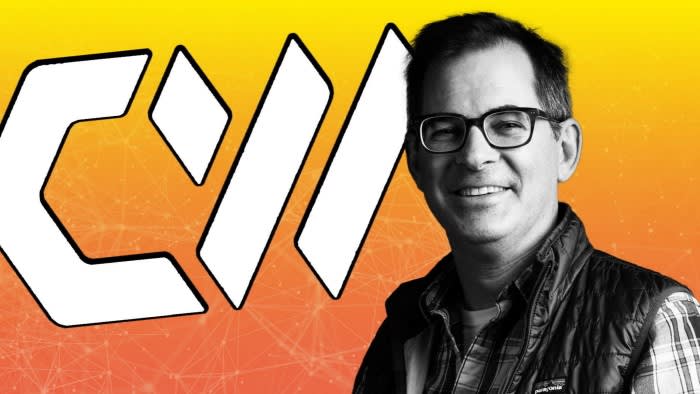A new challenger to cloud computing giants Amazon and Microsoft is using its alliance with Nvidia to turn artificial intelligence chips into a “new asset class” and raise billions of dollars.
New Jersey-based CoreWeave, which was founded in 2017 by former energy traders as a cryptocurrency miner, has raised $8.6 billion in debt and equity over the past month to boost its valuation to $19 billion. A year ago, Nvidia took a $100 million stake that valued it at $2 billion.
The price jump highlights how CoreWeave has become another beneficiary of growing demand for AI chips that has pushed Nvidia to a $2.8 trillion valuation and boosted the stocks of other chipmaker partners such as Dell and Supermicro. Now the company is looking to use that capital by building facilities in the UK and Europe.
CoreWeave leases access to its coveted supply of Nvidia chips, including the in-demand H100 and upcoming B200, running inside its data centers. Its facilities are designed to accommodate the unique demands of high-performance computing, from high-speed networking between AI chipsets to liquid-cooled servers, said Michael Intrator, its chief executive.
CoreWeave’s investors, including hedge fund Magnetar Capital, Blackstone and Coatue, are betting that increased demand for specialized AI services will reshape the $500 billion cloud computing market, despite the tens of billions that Big Tech companies are spending spend on their data centers.
“The way the cloud will be used for the next generation is very different from how the cloud was used at its inception 20 years ago,” Intrator said, calling the company Tesla the Ford of Big Tech.
Intrator said it was “very difficult” to offer its earliest lenders, who had to become “experts in an area they knew nothing about, to the point where they could lend billions of dollars and t ‘took them to their investment committee to propose a new asset class’, such as using Nvidia’s graphics processing units as collateral.
CoreWeave had long moved away from cryptocurrencies when the November 2022 Microsoft-backed release of OpenAI’s ChatGPT sparked a huge wave of demand for AI computing.
Seizing its opportunity, the company quickly ramped up its financing efforts.
It raised more than $420 million in the first half of 2023 in equity, then another $2.3 billion in debt financing a few months later. Some existing shareholders sold shares worth $642 million to Fidelity and others in December. Then, last month, it made two more deals to raise $7.5 billion in debt and $1.1 billion in equity.
CoreWeave needed the funding to “be able to scale enough that we could support anyone who wanted to participate in the AI boom,” Intrator said, regardless of how many thousands of chips they needed.
Now CoreWeave is aiming for rapid expansion in Europe. It unveiled plans on Wednesday to invest $2.2 billion to build three data centers in Norway, Sweden and Spain by the end of next year. It recently committed $1.3 billion to two facilities in the UK, where it has its European headquarters.
To expand faster in the US, CoreWeave this week announced a partnership with Core Scientific, a bitcoin miner, to repurpose some of its data centers to host its GPUs. Bloomberg reported on Tuesday that CoreWeave had also offered to buy Core Scientific outright for more than $1 billion. The companies have not commented on the report.
Like Amazon Web Services or Microsoft’s Azure, CoreWeave offers an alternative to companies that buy and maintain their own servers, providing flexible access to computing power.
But unlike AWS, which was founded in 2006 and can host an almost infinite range of applications and data, CoreWeave’s data center serves a specific set of customers with extremely high-performance computing demands, from AI and drugs to media groups.
Despite its reliance on Nvidia GPUs for the core of its service, Intrator argued there was a “misunderstanding” about CoreWeave’s relationship with the world’s most valuable chip maker. “Nvidia is not giving us access to GPUs because they have some vested interest in us or because we have advantageous access.”
Its competitive advantage was more than just having the right chips, Intrator said. For example, CoreWeave had developed software that automatically manages and maintains GPU clusters.
He raised questions about whether potential investors were concerned about backing a business that had raised capital from Nvidia, only to spend a significant portion of those funds on that company’s products.
“It’s such a wrong narrative,” he said. “Nvidia invested $100 million. we have [raised] $12 billion in debt and equity. It’s an insignificant amount of money relative to the amount of infrastructure we’re buying.”
Nvidia also denied that the companies it invested in had preferential access to its new products. “We don’t help anyone jump the queue,” Mohamed Siddeek, head of Nvidia NVentures’ venture arm, told the Financial Times last year.
However, Intrator said that having Nvidia look at CoreWeave’s business and agree to invest was “an incredibly powerful tool” when it came to raising capital.
“There are an awful lot of questions that I’m able to answer based on the fact that people who know more about this than anyone else are willing to put huge amounts of capital behind what we’re doing,” he said. .
He was able to convince lenders to raise billions of dollars using a combination of GPU’s assets, the value of long-term contracts signed with customers and a “proven ability to execute,” Intrator added.
By the end of 2024, CoreWeave would have 28 data centers across the US and Europe, with plans to create a “true global footprint” over the next two years. “The company is continuing to scale as quickly as possible,” Intrator said.
